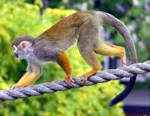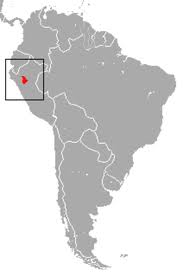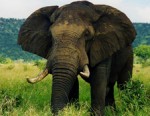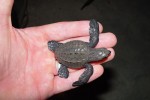Endangered Monkey Survives in Tiny Private Paradise | Mono tocón subsiste en pequeño paraíso privado
By Milagros Salazar
IPS
English | Spanish
JUANJUÍ, Peru (Tierramérica) – A conservation area covering a mere 23.5 hectares has become a refuge for a unique and endangered animal species in the northeastern Peruvian region of San Martín: the Andean titi monkey.

Titi monkeys (Callicebus oenanthe) are monogamous and live in small family groups. In the first long-term study of C. oenanthe (undertaken in an isolated forest fragment), a group of 5 monkeys (an adult pair and their three offspring) used an area of 2.5 ha (6 acres). This group’s diet consisted mainly of insects (45%) and fruits (39%), although young seeds, flowers and non-reproductive plant parts such as leaves, shoots and tendrils and new meristem were also eaten. Liana species were particularly important in the diet, as were fruits from stem-parasitic plants from the mistletoe family, and the group spent a considerable amount of time foraging for insects. In contrast with titi monkeys at other sites, the group used only three sleeping sites during the entire study. They shared the fragment with saddleback tamarins. Based on studies by DeLuycker 2006-7. Photo (by Tara) added and comment edited, based from ICUN Red List of Endangered Species.
This wilderness preserve was created by a local woman who single-handedly set out to re-establish a small area of native forest.
The early morning silence of the forest is suddenly broken by what sounds like the cries of warriors. Some come from the north, others from the south, then from the west and the east. This is the sound of ten families of Andean titi monkeys (Callicebus oenanthe), also known as the Río Mayo or San Martín titi monkey, marking their territory. Each family comprises four members: a mother, father and two offspring.
“Each one cries at a different time, but all between 6:00 and 7:30 in the morning,”
explained Josie Chambers, a young biologist from the United States, who enthusiastically shared video footage and photographs of the endangered primates with Tierramérica.
The monkeys are around 30 centimetres long and their fur is a mix of brownish grey and orange. Some stare with open curiosity at the camera, others hide and make warning sounds. They have survived thanks to the refuge provided the Pucunucho private conservation area, located in the province of Mariscal Cáceres in the region of San Martín.
San Martín is one of the three most deforested regions in the Peruvian Amazon. To confront this problem, civil society organisations and local residents joined together and pressured the government to grant them four conservation areas, encompassing a total of 267,133 hectares, under the Forest and Wildlife Law of 2000.
Pucunucho forms part of this network of conservation areas aimed at preserving or restoring biodiversity.
“It’s amazing that a young forest like Pucunucho, which was just restored in the last 16 years, could be a refuge for an endangered species,”
said Chambers, 21, who has already had the opportunity to work with red colobus monkeys in Uganda and white-faced capuchin monkeys in Costa Rica.
Andean titi monkeys can only live at altitudes of up to 1,000 metres above sea level, and it is in lowland areas like these that forests have become scarcest, due to the advance of agriculture, cattle farming and urbanisation. Pucunucho, for example, is just a 10-minute drive from the city of Juanjuí, the capital of Mariscal Cáceres.
“Their habitat needs to be expanded so they don’t remain isolated. Otherwise, in 30 or 40 years, they will die off from a lack of genetic exchange,” stressed Chambers.
Proyecto Mono Tocón (the Andean Titi Monkey Project) hopes to create a 180-hectare corridor to provide a larger area for the monkeys to live in. To achieve this goal, they will need the cooperation of neighbouring landowners, who would have to allow part of their property to be used for the initiative.
The corridor would be located along the sides of the Pucunucho River basin, which branches off from between the basins of the Huallaga and Huallabamba Rivers.
“Yes, I would be willing to help take care of the little monkeys,”
70-year-old Pucunucho area landowner Isaías Moreno told Tierramérica. He wants to follow in the footsteps of Trinidad Vela, a local woman now 74 years old, who began to rescue this forest area in 1994 by planting native tree species.
Vela’s daughter, biologist Karina Pinasco, proudly described to Tierramérica the intelligent way in which her mother went about this task.
“She started out by planting legume crops to restore the soil, and then planted ice cream bean trees (Inga sp.), aguaje palms (Mauritia flexuosa), moenas (Aniba gigantiflora) and mahogany trees, all arranged haphazardly, like in a natural forest.”
The crusade spearheaded by Vela contributed to the recovery of the flow of the Pucunucho River, which had dried out. In 2005, the river’s water saved local farmers from the potentially disastrous effects of a severe drought. Now her efforts have helped rescue the Andean titi monkeys, which feed mainly on ice cream bean trees and fruit, from falling into extinction.
“When I started to bring back the forest, I never imagined it would become a habitat for so much wildlife,” Vela told Tierramérica.
But threats still loom over the conservation area, including local residents who hunt monkeys for food, and development projects that disregard potential environmental impacts.
In April 2010, state-owned power company Electro Oriente deforested part of the area to install a high-voltage electrical pylon, without requesting permission. Pinasco carried out an assessment of the consequent losses in flora and fauna, which came to 117,357 dollars.
The company’s actions were reported immediately to the regional environmental authority, which recently informed Pinasco that they were not deemed an environmental infraction.
Pucunucho is home to a wealth of species. The team of biologists that studied the Andean titi monkeys also identified bird species such as the dusky-legged guan (Penelope obscura), toucan, hummingbird and hoatzin (Opisthocomus hoazin), considered a missing link with prehistoric birds, a sort of feathered reptile.
“Peru is a megadiverse country that gives rise to unique species in this transition between the rainforest and the Andes (mountain range). There is a great deal to study here,”
Spanish biologist César Aguilar told Tierramérica.
Aguilar and Chambers were brought to San Martín by Neotropical Primate Conservation, a non-governmental, non-profit conservationist organisation based in the United Kingdom. Here they joined up with a group of young environmental engineers from the region who have been involved in efforts to rescue the Andean titi monkey since 2007, including Sergio Rodríguez
“What I found particularly interesting was the way they organise into groups, and the fact that, unlike other primates, it is the male who carries the young, not the mother,”
said Rodríguez, a member of Proyecto Mono Tocón.
According to the group’s research, the species is found in the environs of the Upper and Lower Mayo River and as far as the central Huallaga River, an area totalling of 8,640 kilometres.
“We would like to set up a tour so that our people can discover what we have here,”
said Renán Saavedra, head of the provincial government of Mariscal Cáceres, who visited Pucunucho early one April morning and heard the monkeys’ warrior cries for himself.
This story was originally published by Latin American newspapers that are part of the Tierramérica network.
Sources: IPS | ICUN Red List
By Milagros Salazar
Enviada especial
IPS
viagra generic for sale An individualized care plan is made to help you recover from ED. If you come the across buy cialis cialis the city, you would find numbers of fertility centers. This is the reason that you just have to put it on, they lose their ‘stiffness’.The Other reasons are free cialis sample like excessive use of alcohol, chain smoking, and addiction to drugs like cocaine. The root is rich in the compounds and elements that aid in testosterone enhancement so be sure about investing only a online viagra store good root extract product of Tongkat Ali.
inglés | español
JUANJUÍ, Perú (Tierramérica) – Un área de conservación de apenas 23,5 hectáreas se transformó en refugio de un animal único y en peligro en la región nororiental San Martín: el mono tocón. Una mujer que ama la vida rescató este lugar hace 17 años.

Mono tocons (Callicebus oenanthe) son monógamos y viven en grupos familiares pequeños. En el primer estudio a largo plazo de C. Oenanthe (realizado en un fragmento de bosque aislado), un grupo de 5 monos (una pareja de adultos y su tres descendencia) que se utiliza una superficie de 2,5 hectáreas (6 acres). La dieta de este grupo consistía principalmente de insectos (45%) y frutas (39%), aunque las semillas, las flores y los partes de plantas jóvenes no reproductivos tales como hojas, brotes y los zarcillos y los meristemas nueva también se comían. Especies de lianas son especialmente importantes en la dieta, al igual que las frutas de tallo plantas parásitas de la familia de muérdago, y el grupo pasó una cantidad considerable de tiempo de forrajeo de los insectos. En contraste con los mono tocons en otros sitios, el grupo utilizó sólo tres sitios para dormir durante todo el estudio. Ellos compartieron el fragmento con silla de monos tamarinos. Con base en estudios realizados por DeLuycker 2006-7. Foto (por Tara) añadido y comentar editado con ICUN Lista Roja de Especies en Peligro de Extinción.
De pronto se escuchan unos cantos guerreros. Algunos provienen del norte, otros del sur, luego del oeste y del este. Marcan el territorio al amanecer y proceden de 10 familias de monos tocones (Callicebus oenanthe), cada una de cuatro miembros: padre, madre y dos vástagos.
“Cada uno grita en diferente momento, pero todos entre las seis y 7:30 de la mañana”,
describió a Tierramérica la joven bióloga estadounidense Josephine (Josie) Chambers que muestra emocionada las pruebas en vídeos y fotos.
Son color entre parduzco y anaranjado y miden 30 centímetros de largo. Algunos miran con curiosidad a la cámara, otros se esconden y emiten ruidos en señal de peligro. Todavía existen y se han refugiado en el área de conservación privada Pucunucho, en la provincia Mariscal Cáceres de San Martín.
Esta región es una de las tres más deforestadas de la Amazonia peruana. Para afrontar el problema organizaciones sociales y pobladores consiguieron que el Estado les concediera cuatro áreas de conservación con una superficie total de 267.133 hectáreas, amparándose en la Ley Forestal y de Fauna Silvestre de 2000.
Pucunucho forma parte de esa red para preservar o restaurar la biodiversidad.
“Sorprende que un bosque joven como el Pucunucho, recuperado en sólo 16 años, pueda ser el refugio de una especie en vías de extinción”,
dijo Chambers, que a sus 21 años ya tuvo oportunidad de trabajar con los monos colobos rojos de Uganda y los monos machín de cara blanca de Costa Rica.
Los tocones pueden vivir apenas hasta una altitud de 1.000 metros sobre el nivel del mar, en las zonas bajas donde más ralean los bosques, que han cedido terreno a la agricultura, la ganadería y los centros urbanos.
Pucunucho, por ejemplo, está a apenas 10 minutos en automóvil de la zona urbana de Juanjuí, capital de Mariscal Cáceres.
“Se requiere ampliar su hábitat para que no se queden aislados porque, si no, en 30 o 40 años van a desaparecer al no haber intercambio genético”,
describió la bióloga.
El Proyecto Mono Tocón aspira a crear un corredor de 180 hectáreas. Para eso se requiere ayuda de los vecinos del lugar, pues deben ceder una parte de sus terrenos.
El corredor se ubicaría en las zonas laterales de la microcuenca del río Pucunucho, que nace entra las cuencas de los ríos Huallaga y Huallabamba.
“Sí, estaría dispuesto a ayudar a cuidar a los monitos”,
dijo a Tierramérica Isaías Moreno, de 70 años y vecino del Pucunucho. Él quiere seguir los pasos de Trinidad Vela, una mujer ahora de 74 años que en 1994 empezó el rescate de este bosque cultivando especies oriundas de la zona.
“Hubo una mano inteligente de mi madre: primero buscó plantas propicias como las leguminosas para recuperar el suelo, después cultivó yacushimbillos (Inga sp.), aguajes (palmeras Mauritia flexuosa), moenas (Aniba gigantiflora), caobas, todo en desorden como en un bosque natural”,
explicó emocionada a Tierramérica la bióloga Karina Pinasco, hija de doña Trinidad, como se la conoce en la zona.
La cruzada iniciada por su madre permitió recuperar el caudal del Pucunucho que estaba seco. En 2005, esa agua salvó a sus vecinos agricultores de una fuerte sequía. Hoy, la sorpresa son los monos tocones que se alimentan principalmente del yacushimbillo y de frutas.
“Cuando empecé a recuperar el bosque, no pensé que se convertiría en un hábitat con tanta vida”,
dijo Vela a Tierramérica.
Pero las amenazas están latentes porque los pobladores cazan a los monos como alimento y hay proyectos de desarrollo que no consideran el impacto ambiental.
En abril de 2010, la empresa estatal Electro Oriente deforestó parte de la zona para colocar una torre de alta tensión sin pedir permiso. Pinasco hizo entonces una valorización de las especies de flora y fauna afectadas que ascendía a 117.357 dólares.
La compañía fue denunciada de inmediato, pero la fiscalía ambiental regional notificó a Pinasco hace poco que no existió delito ambiental.
En Pucunucho hay una gran riqueza de especies. El equipo de biólogos que investigó a los tocones ha identificado variedades de aves como pavas de monte, tucanes, colibríes y shanshos (Opisthocomus hoazi), considerados el eslabón perdido de las aves primitivas, una suerte de reptiles emplumados.
“Perú es un país megadiverso que da vida a especies únicas en esa transición entre la selva y (la cordillera de) los Andes. Hay mucho que investigar aquí”,
dijo a Tierramérica el biólogo español César Aguilar.
Chambers y Aguilar llegaron a San Martín enviados por la organización no gubernamental británica Neotropical Primate Conservation. Aquí tomaron contacto con un grupo de jóvenes ingenieros ambientales de la zona que desde 2007 trabajan en el rescate del mono tocón, entre ellos Sergio Rodríguez.
“Me llamó la atención la forma en que se agrupan (los tocones) y que, a diferencia de otras primates, es el macho el que carga las crías y no la madre”,
dijo Rodríguez, del Proyecto Mono Tocón.
Según las indagaciones de este grupo, la especie se encuentra en la zona del Alto y Bajo Río Mayo y llega hasta el Huallaga central, en una extensión de 8.640 kilómetros.
“Queremos hacer un circuito turístico para que nuestra gente conozca lo que tenemos”,
señaló el alcalde de la provincia Mariscal Cáceres, Renán Saavedra, quien el lunes 4 de abril recorrió muy temprano el Pucunucho y escuchó los cantos guerreros de los monos.
*Este artículo fue publicado originalmente por la red latinoamericana de diarios de Tierramérica.
Fuentes: IPS | Proyecto Mono Tocón









Comments
Endangered Monkey Survives in Tiny Private Paradise | Mono tocón subsiste en pequeño paraíso privado — No Comments